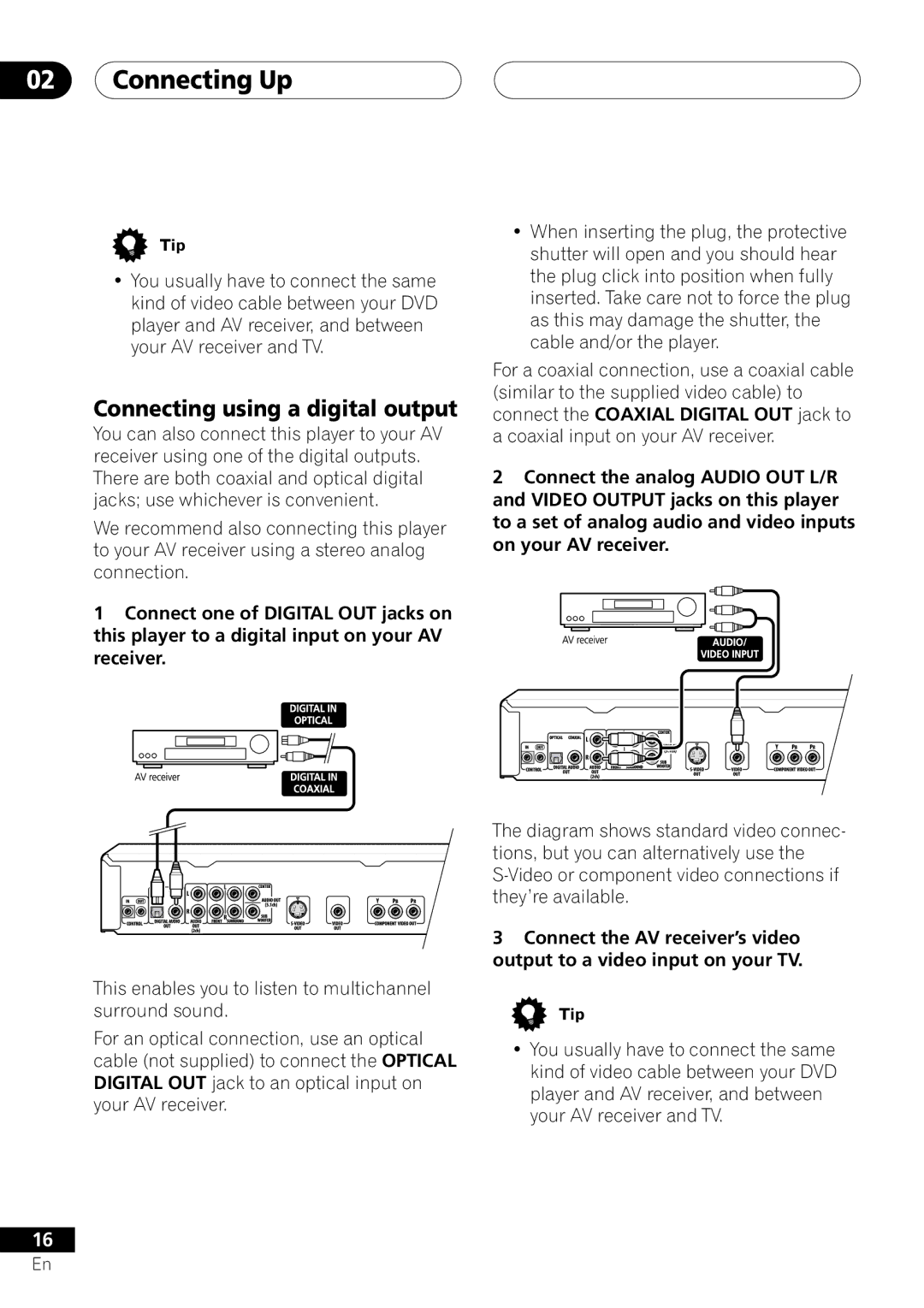DV-45A
Important Safety Instructions
For U.S. model
Important Notice
For Canadian model
Page
Contents
Connecting for multichannel surround
Connecting using the multichannel analog
CD-R/RW Compatibility
Setting/changing the CountryCode
Creating your own progressive output
Before You Start Features
DVD-Audio and Sacd compatible
Using the remote control
Putting the batteries in the remote control
Before You Start What’s in the box
Photo CD / DVD-RAM / DVD-ROM
CD-ROM
Before You Start
CDs, SACDs and Video CD are divided into tracks
Connecting Up Rear panel
Control in / OUT
Digital Audio OUT Optical / Coaxial
Video OUT
Connecting Up Easy connections
Connecting using an S-Video output
Connecting Up Using other types of video output
Connecting using the component video output
Connecting Up
Connecting for multichannel surround sound
Connecting using a digital output
Controlling this player from another Pioneer component
STANDBY/ON
Controls and Displays Front panel
OPEN/CLOSE
Controls and Displays
About progressive scan video
Part
Prgsve
GRP TRK
Remain
Controls and Displays Remote control
Preset code list
Setting up the Remote Control to
Getting Started Switching on
Press Enter again to finish setting up
Getting Started
Let’s Get Started
Press Enter to move on to the next screen
Getting Started Using the on-screen displays
Setting up with the Setup Navigator
Select ‘Setup Navigator’
Joystick
Select a DVD language
Did you connect this player to an AV receiver?
Congratulations, setup is complete
Getting Started Playing discs
Basic playback controls
Press 0 OPEN/CLOSE to open the disc tray Load a disc
Press 3 play to start playback
Front panel controls
DVD disc menus
Stops playback
¢ Skips to the next track or chapter
Video CD PBC menus
Numbers
Why won’t the disc I loaded play?
Some MP3 tracks don’t show up. Where are they?
Disc may have been illegally copied
Using the Disc Navigator to browse the contents of a disc
Playing Discs Introduction
For CDs and Video CDs select a track
MP3
Playing Discs Scanning discs
Using the Multi Dial
To resume normal playback, press Play
Playing Discs Playing in slow motion
Frame advance/frame reverse
Press repeatedly to change the slow motion speed
Slow motion speed is displayed on- screen
Press Enter on ‘BEnd Point’ to set the loop end point
Playing Discs Looping a section of a disc
Press Enter on ‘AStart Point’ to set the loop start point
Playing Discs Using repeat play
Playing Discs Using random play
Select a random play option
Random Title Random Chapter Random Off
Random Group Random Track Random Off
Playing Discs Creating a program list
Select ‘Create/Edit’ from the list of program options
Chapters/groups/folders/tracks
Program list can contain up to 24 titles
To play the program list, press
Other functions available from the program menu
Editing a program list
Select a program play function
Playing Discs Searching a disc
Press Enter to start playback
Playing Discs Switching subtitles
Switching DVD-Video audio language
Press Subtitle repeatedly to select a subtitle option
Press Audio repeatedly to select an audio language option
Playing Discs Switching DVD-RW audio channel
Switching DVD-Audio audio channel
Switching CD/MP3/Video CD audio channel
Switching camera angles
Playing Discs Displaying disc information
During PBC playback only
Audio Settings Menu Audio DRC
Audio Settings Menu Virtual Surround
TruSurround’ or ‘Off’, as required
Audio Settings Menu Channel Level
Default setting Fix / all speakers 10 ft
Audio Settings Menu
Fix and Variable settings Set the distance for each speaker
Video Settings Menu Video Adjust
Creating your own interlace output presets
Use the joystick left/right to select a preset
Adjust the picture quality settings
Creating your own progressive output presets
Video Settings Menu
Ajust the picture quality settings
Initial Settings Menu Using the Initial Settings menu
Digital Audio Out settings
Digital Out
Dolby Digital Out
Initial Settings Menu
Default setting Mpeg PCM
Mpeg Out
DTS PCM
Video Output settings
TV Screen
Auto Progressive
Video Out
Language settings
Default setting Auto
Default setting English
Still Picture
Default setting English Default setting On
Subtitle Language Auto Language
Display settings
DVD Menu Language
Subtitle Display
OSD Language
Angle Indicator
Options
Background
Screen Saver
Select ‘Password’
Use the number buttons to enter a 4- digit password
Select ‘Password Change’
Enter a new password
Use number buttons to enter your password, then press Enter
Select ‘Level Change’
Select ‘Country Code’
Select a new level
Bonus Group
Auto Disc Menu
Group Playback DVD Playback Mode
Default setting Single Default setting DVD-Audio
Default setting 2ch Area
Sacd Playback
Initial Settings Menu CD Playback
Audio Output Mode
Speaker Installation
Speakers
Speaker Distance
Default setting all speakers 10 ft
L and R speakers are paired you can’t set them differently
Use the joystick up/down to change
Distance
Front left/right speakers
Move the cursor left to go back to
Manual Move the cursor up/down to select a speaker
Additional Information Taking care of your player and discs
Handling discs
Storing discs
Discs to avoid
Additional Information
Resetting the player
Additional Information Screen sizes and disc formats
Widescreen TV users
Standard TV users
Additional Information About the audio output settings
Bitstream*3
Additional Information Language code list
Country code list
Language Language code letter, Language code
Country, Country code, Country code letter
DTS
Glossary
MP3
Mpeg audio
Mpeg video
Packed PCM DVD-Audio only
PCM Pulse Code Modulation
Additional Information Troubleshooting
Settings are canceled
Remote control doesnt
Disc won’t play or is automatically ejected after loading
Screen is stretched or aspect does not change
Video OFF button
No audio, or audio is dis- torted
CD volume
Output
Cannot output 192kHz or
176.4kHz digital audio
Disc containing the MP3 tracks won’t play
Can’t hear effect
TruSurround
96kHz linear PCM DVD
General
Additional Information Specifications
Other terminals
TPTZW/02E00001 Printed

